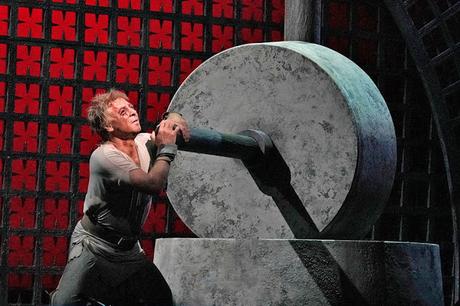by Paul J. Pelkonen

A world of toil: Robert Alagna does hard time in Samson et Dalila.
Photo by Ken Howard © 2018 The Metropolitan Opera.
The big story coming out of Monday's season-opening performance of Camille-Saint-Saëns' Samson et Dalila was the onstage vocal collapse of Roberto Alagna, the internationally reputed tenor saddled with the role of Samson. Shorn of his tresses and blinded by Philistine thugs, this Samson appeared to loses his vocal strength along with his muscles, having very little voice for the opera's demanding final scenes.
The problems started for Mr. Alagna in the the first act. In Samson's heroic attack on the Philistine priest Abimélech (Elchin Azizov) the singer sounded querulous and unsure, with a wide vibrato at full voice that was distressingly thin at the top and threatened to wobble. His instrument settled at last for the big scenes with Dalila (Elina Garança, more on her in a moment. Their first encounter and the big duet in Act II (that ends with his capture, the shearing of his hair and his blinding) were powerful and thrilling to hear.
It was in the demanding third act, starting with "Vois ma misère, helas" Mr. Alagna's misery really started: with the voice turning to a watery croak when he reached for what should have been the climactic notes. For the last part of this aria, he collapsed in misery next to the prompter's box, his distress visible to the capacity house. In the final scene, his last lines of prayer to the Lord collapsed into a blurred morass of attempted sound as the singer simply ran out of voice.
As Dalila, Ms. Garança exuded presence and sexuality despite being trapped in a role two sizes too big for her instrument. She sang "Voici le printemps" with rich and suggestive tone, putting warmth into each line despite being flanked by a chilly, sterile set. In Act II, the character's grand aria "Mon coeur s'ouvre à ta voix..." she found the right, sensual sound. She found it more challenging to cope with the character's hard-edged persona, although her big duet with the High Priest (Laurent Naouri) was a highlight. Later, she carried Mr. Alagna in the duet and they got through the big seduction scene, generating the only real excitement of the evening.
Some of the problems with this work lie with Saint-Saëns himself and his creative process. In choosing Biblical subject matter, he was on the fence as to whether he was writing an oratorio (as tradition dictated for such subject matter) or a fully-staged opera. As a result there are passages that do not work well in a dramatic setting, such as the quiet, unexpected and sudden ending to the first act. Most seriously, the slam-bang finish presents huge problems for any director as as Saint-Saëns's music demands that the Temple of Dagon collapse in just twenty seconds.
Sir Mark Elder took a judicious and academic approach to the score, with certain passages like the Chorus of Hebrews in the first act at a glacial tempo that taxed the singers and the audience's attention. He was helped by the crack Met orchestra who could play this work in their sleep and managed to generate enough beauty and firepower to wake up the audience. The chorus, expertly prepared by Donald Palumbo were absolute stars, sailing through Saint-Saëns' complex contrapuntal writing for the lamenting Hebrew people. In the third act, the choristers were now Philistines, confined to the upper tiers of the sets and loudly singing the praises of their pagan god.
The supporting parts in this opera are small. Mr. Naouri led these as the High Priest with warm and burry tone. Dimitry Belosselskiy made a strong impression as the Old Hebrew, leaving on to wish that the part were longer. Director Darko Tresnjak seemed to have little idea on how to block the actors or get them to interact convincingly. The singers were trapped in the kitschy designs of Alexander Dodge, whose crayon-box palette and fetish for cheap-looking latticework fell somewhere between Hollywood-style Bible epic and late-season low-budget Star Trek.

